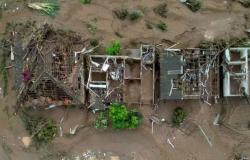Data from the Jones dos Santos Neves Institute (IJSN), of the government of Espírito Santo, based on the Continuous National Household Sample Survey (Pnad Contínua), indicate that Mato Grosso do Sul had reductions in poverty and extreme poverty rates in the last year .
The State went from 21.3% of people living at the poverty line in 2022, that is, living on up to R$664.02 per month, to 19.3% last year. The reduction was just 2%, one of the smallest in the country, which saw a reduction of 4.2% in one year. Only Acre had an increase in the poverty rate, of 0.4%.
The extreme poverty rate, which concerns people living on up to R$ 208.42 per month, fell from 2.7% to 2% in the State, representing a reduction of 0.7%, while the reduction in Brazil was of 1.5%.
The Federal District and Rondônia were the federation units that showed an increase in extreme poverty, of 0.2% and 0.3%, respectively.
The extreme poverty rate of 2% is in line with the promise that Governor Eduardo Riedel (PSDB) made at the beginning of this month, during the visit of President Luiz Inácio Lula da Silva (PT), to the State.
“We have the third lowest unemployment rate in the country, but what we are most proud of is that we are going towards the second lowest rate of extreme poverty in this country and I will finish this term by eradicating extreme poverty in Mato Grosso do Sul”, guaranteed Riedel during his speech at an event held during the president’s visit.
However, despite Mato Grosso do Sul having one of the lowest rates of extreme poverty in the country, the State is 5th in this ranking. Rio Grande do Sul and Goiás have the lowest rate of people living below the poverty line, at 1.3%. Santa Catarina, with 1.4% and the Federal District, with 1.9% are also ahead of MS in relation to the lowest rates.
Regarding the poverty line, the State went from 6th place in the ranking of the lowest rates in the country, to 8th place. This is because MS had the 4th lowest reduction in poverty, while other states had more significant rates, such as Rio Grande do Sul, which managed to reduce 2.4% and Amapá, which had the largest reduction, of 14.8%.
Even with reductions that are not as significant as other states, Mato Grosso do Sul is an important ally in the government’s agenda of reducing inequalities in the country. In January this year, the Minister of Development and Social Assistance, Family and Combating Hunger, Wellington Dias, stated that MS would be the first state to leave the Hunger Map in Brazil.
A survey carried out by the Brazilian Institute of Geography and Statistics (IBGE) reports that MS also recorded a drop in the rate of food insecurity. The study was carried out in the fourth quarter of 2023, and shows that 4.04% of people in the State live in severe food insecurity, 15.11% with moderate food insecurity and 21.75% with mild food insecurity.
In total, the Institute points out that there are 27 thousand households in the State that had to cut food even for the children in the family. Even so, MS has one of the best food security rates in the country, with 78.2% of households in this situation, occupying the 7th best place in the ranking among the federation units.
POPULATION
In November last year, a large fire hit the Mandela community, in Campo Grande, and to this day, families are waiting for housing and social assistance from the city hall.
Jaqueline Soares da Silva, 40 years old, lives with six other people in the community and is one of the residents waiting for a house, even if hers was not affected by the fire.
Maria Gabriele Mendes, 18, also lives in Mandela with her family of five, and reports that she feels “isolated”, as other residents, affected by the fire, found a house outside the area, and some “stayed” .
“The septic tanks were left open, there were a lot of cases of dengue fever here, and then more holes were opened in the shacks, water got on the ground, it became more difficult (after the fire)”, says Maria. She and her family report that the help they received from the city hall ended after the fire, but that they were promised by the municipal executive that they would go to the same place as the others affected by the tragedy.
Maria Gabriele registered with the Municipal Housing and Land Affairs Agency (Amhasf), and is also waiting for housing. Meanwhile, she and her husband share household expenses to support the family.
“There were vegetables, now what we still have is milk, vegetables are from time to time, but we had them all week. There was a children’s snack on Saturday, and now they have cut it too. It’s not what it used to be like that community was. The feeling is of having chosen ones”, said the resident.
“Working is difficult and complicated”, comments Jaqueline, who is hearing impaired. The resident informs that she lives on donations of food and clothes, and among the difficulties in the community she highlights the lack of care, as the municipality’s cleaning services do not reach the area, and there are many dengue mosquitoes and other animals such as scorpions and snakes.
Aid is essential in reducing poverty rates and food insecurity. The State government informs that it annually invests around R$700 million of the budget in social programs and transfers to the low-income population, and also highlighted that it has been adopting initiatives to improve people’s lives, “reducing the cost of living and offering opportunities” such as jobs.
Among the measures is the Mais Social program, which transfers R$450 per month to low-income families, who can use this resource for food and hygiene products, for example.
Subscribe to the State Mail







